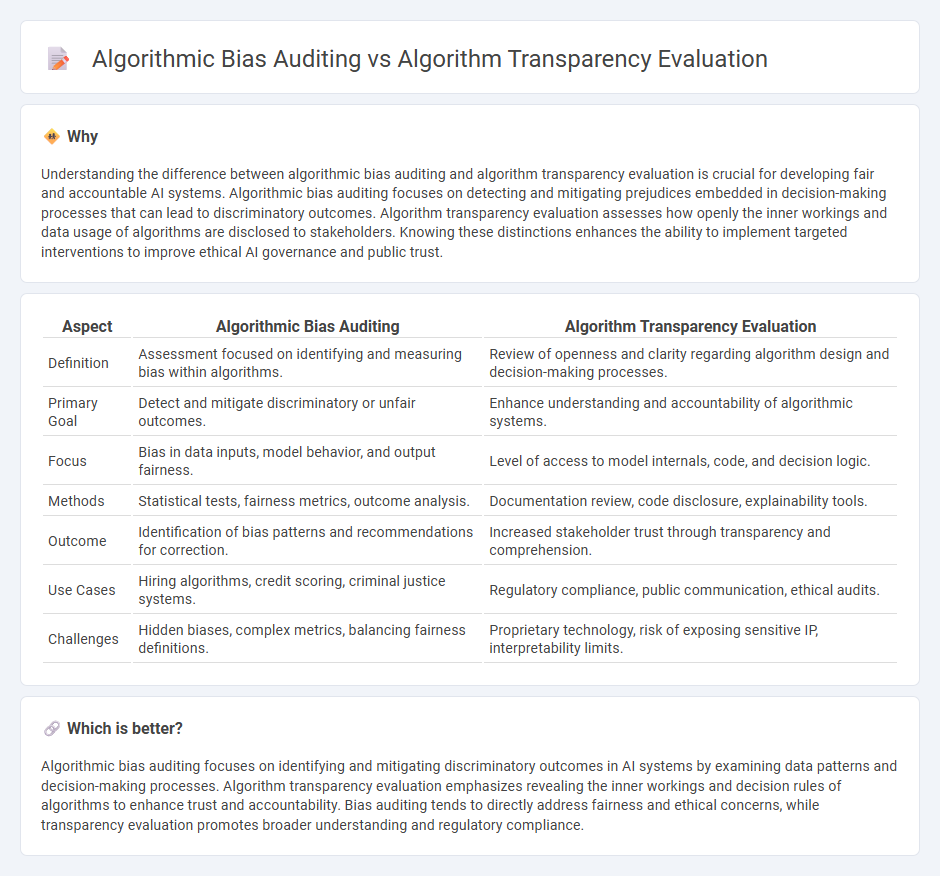
Algorithmic bias auditing identifies and mitigates unfair or prejudiced outcomes within AI systems by analyzing data patterns and decision-making processes for discriminatory effects. Algorithm transparency evaluation emphasizes the clarity and interpretability of algorithms, making their mechanisms understandable to users and stakeholders to foster trust and accountability. Explore the nuances of these approaches to enhance ethical AI development and deployment.
Why it is important
Understanding the difference between algorithmic bias auditing and algorithm transparency evaluation is crucial for developing fair and accountable AI systems. Algorithmic bias auditing focuses on detecting and mitigating prejudices embedded in decision-making processes that can lead to discriminatory outcomes. Algorithm transparency evaluation assesses how openly the inner workings and data usage of algorithms are disclosed to stakeholders. Knowing these distinctions enhances the ability to implement targeted interventions to improve ethical AI governance and public trust.
Comparison Table
| Aspect | Algorithmic Bias Auditing | Algorithm Transparency Evaluation |
|---|---|---|
| Definition | Assessment focused on identifying and measuring bias within algorithms. | Review of openness and clarity regarding algorithm design and decision-making processes. |
| Primary Goal | Detect and mitigate discriminatory or unfair outcomes. | Enhance understanding and accountability of algorithmic systems. |
| Focus | Bias in data inputs, model behavior, and output fairness. | Level of access to model internals, code, and decision logic. |
| Methods | Statistical tests, fairness metrics, outcome analysis. | Documentation review, code disclosure, explainability tools. |
| Outcome | Identification of bias patterns and recommendations for correction. | Increased stakeholder trust through transparency and comprehension. |
| Use Cases | Hiring algorithms, credit scoring, criminal justice systems. | Regulatory compliance, public communication, ethical audits. |
| Challenges | Hidden biases, complex metrics, balancing fairness definitions. | Proprietary technology, risk of exposing sensitive IP, interpretability limits. |
Which is better?
Algorithmic bias auditing focuses on identifying and mitigating discriminatory outcomes in AI systems by examining data patterns and decision-making processes. Algorithm transparency evaluation emphasizes revealing the inner workings and decision rules of algorithms to enhance trust and accountability. Bias auditing tends to directly address fairness and ethical concerns, while transparency evaluation promotes broader understanding and regulatory compliance.
Connection
Algorithmic bias auditing identifies discriminatory patterns in AI systems by examining data inputs and decision-making processes. Algorithm transparency evaluation ensures these processes are openly accessible and interpretable, allowing stakeholders to understand how algorithms function. Together, they promote accountability and fairness in technology by enabling detection and correction of biased outcomes.
Key Terms
Explainability
Algorithm transparency evaluation centers on making AI systems' decision-making processes understandable through explainability techniques, enhancing user trust and regulatory compliance. Algorithmic bias auditing specifically investigates unfair or discriminatory outcomes within these systems, relying on transparency to identify and mitigate bias effectively. Explore deeper insights into explainability's critical role in balancing transparency and bias auditing to optimize ethical AI deployment.
Fairness metrics
Algorithm transparency evaluation emphasizes clear, interpretable explanation of decision-making processes to enhance trust and accountability, while algorithmic bias auditing focuses on identifying and mitigating discriminatory patterns in data or outcomes using fairness metrics such as demographic parity, equal opportunity, and disparate impact. Fairness metrics quantitatively assess algorithmic biases by measuring disparities across protected groups, enabling targeted improvements and compliance with ethical standards. Explore deeper insights into applying these metrics to ensure equitable AI system deployment.
Accountability
Algorithm transparency evaluation assesses how openly algorithmic processes and decision-making criteria are disclosed, enabling stakeholders to scrutinize system operations and detect potential biases. Algorithmic bias auditing specifically targets identifying and mitigating unfair or discriminatory outcomes within algorithms, ensuring equitable treatment across diverse populations. Explore deeper insights into how these approaches enhance accountability in artificial intelligence systems.
Source and External Links
What is Algorithmic Transparency? - Avahi - Algorithmic transparency involves disclosing the data provenance and quality, the model architecture and logic, and the explainability of outputs, so stakeholders understand how the algorithm works and its limitations.
State of the Evidence: Algorithmic Transparency - Algorithm transparency evaluation requires not just public availability but also accessibility for independent experts to inspect and assess algorithms; explainability ensures outputs are interpretable by humans for auditing purposes.
Algorithmic Transparency * by Adigital - Evaluation of algorithm transparency emphasizes providing clear information about data sources, decision criteria, and algorithm structure, alongside explainability which bridges technical complexity with human-understandable insights to foster accountability and trust.
 dowidth.com
dowidth.com